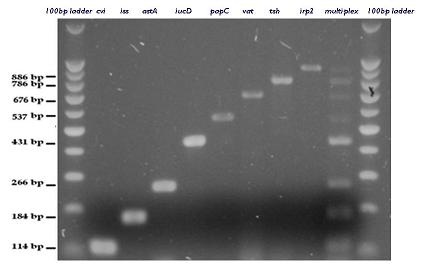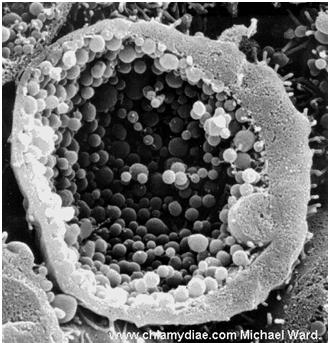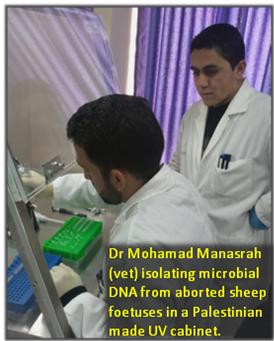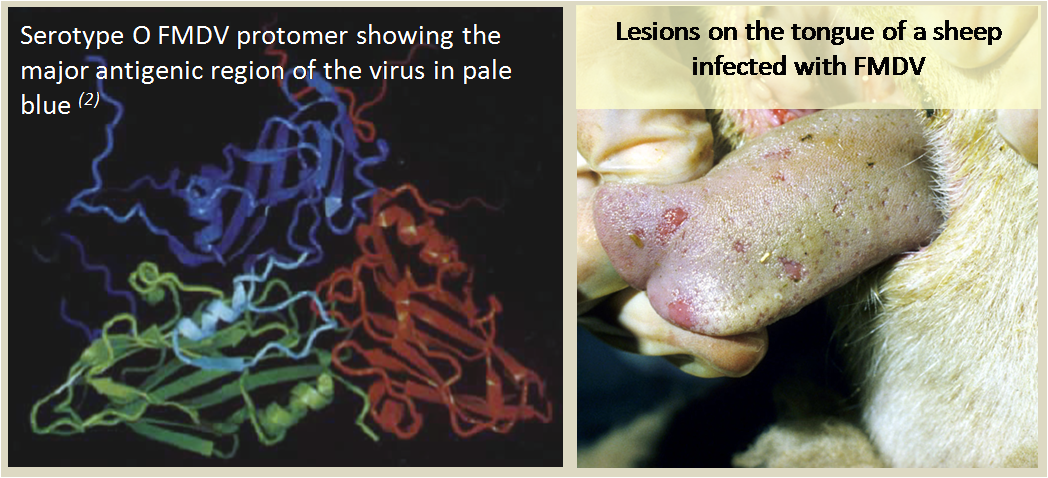Avian pathogenic E. coli (APEC)
Avian pathogenic E.coli (APEC) strains cause diseases in birds at various ages. The introduction of such strains to chicken via their respiratory tracts causes an invasive infection featured with multi-extraintestinal disorders, collectively known as colibacillosis. The impact of APEC infection on broiler chicken can be severe. It can cause a massive death in broiler flocks that leads to great economic losses for the poultry industry worldwide.

Recent reports showed that the pathogenecity of APEC strains are associated with certain virulence genes that are located within the bacterial genome (papC, astA, vat, and irp2) and/or their CoIV plasmids (tsh, iucD, iss, and cvi) (Dziva F. & Stevens MP. 2008) Identification and characterization of these genes are essential to implement an efficient disease control and prevention systems.
The massive and indiscriminate use of antibiotics increases the risk of development of drug-resistant strains of APEC that constitute a zoonotic risk as a potential reservoir of Extended-spectrum beta-lactamases (ESBL) antimicrobial resistance genes (Cortes et al. 2010). The uncontrolled use of antibiotic in poultry industry is a worrisome phenomenon that can have serious impact on the public health of the Palestinian society.
We aim at studying the molecular signatures and antibiotic resistance profiles that are associated with APEC strains isolated from broiler flocks in Palestine. In addition, the study aims at comparing the genotypes of APEC strains and human pathogenic E.coli.
Researchers: Yaqoub Ashhab, Mohammad Qabajah, Ala’ Darwish
Pathogenomic Brucella melitensis
Brucellosis is one of the world’s major zoonotic problems in low-income countries, where the control programs have not succeeded in eradicating this neglected disease. The recently published map of Brucellosis in humans shows that this disease is still a major uncontrolled public health in several endemic regions such as Mediterranean, Middle East, Africa, Central Asia, Mongolia and some provinces in northeastern China and parts of Latin America (Pappas et al. 2006). In Middle Eastern countries the annual incidence of brucellosis ranges from 1 to 78 cases per 100,000. The number is much greater in some confined endemic areas that lack animal control measures and poor public health services such as southern parts of Palestine and eastern Syrian Desert (FAO technical meeting 2009).The FAO report raise the alarm that the infection has re-emerged, with high prevalence in sheep and goats in other countries and, in particular, in Eastern Europe, the Balkans, and Eurasia.
Brucellosis in domestic animals is a major cause of direct economic losses. It is also a major hurdle for the trade of animals and dairy products. The magnitude of animal brucellosis problem is several folds more serious among small livestock owners in many rural populations. The adverse effect on this important and vulnerable agricultural sector could gravely impair socio-economic development in many regions through the world. The Palestinian Brucellosis Control Program started in 1998, adopting the strategy of mass vaccination of sheep and goats (all ages and both sexes) via the conjunctival route using full dose Rev.1 vaccine. In the same year, the Palestinian Ministry of Agriculture (MOA) revealed that more than 18.6 % of small ruminants (sheep and goat) were positive for B melitensis, while 72.9% of herds were affected, with more than 70% of these cases in Hebron district (MOA 1998)
In 2008, and after 10 years of commencing the Brucellosis Control Program, Brucellosis is still a major problem in the southern parts of West-Bank. Despite the significant reduction of its prevalence both in human and domestic animals, this pathogen still has hidden secrets to tell. Current emphasis is place on the use of genomic sequences that are available in various biological databases to reveal distinctive genetic markers that can be useful in developing novel diagnostic tools. Identification of genetic variants will give insight into the molecular pathogenesis of Brucella. In addition, revealing such natural genetic variations can have implications for better understanding of brucellosis epidemiology and control of its infection.
Researchers: Yaqoub Ashhab, Mohamad Nouh Issa

Enzootic abortion (OEA) in small ruminants
Despite many generously funded and diligently executed vaccination campaigns, OEA is still causing (Spring 2012) considerable losses in Palestinian sheep and goats. OEA is caused by Chlamydophilla abortus, which is shown in the electron micrograph below as reticulate bodies around the inner periphery of a freeze-fractured inclusion body within a host cell.
The objectives of our research into this disease are:
- Establish a local PCR protocol for differential diagnosis.
-
Survey the extent of correlation, reported by some farmers, between prior vaccination and subsequent abortion events

- Examine the efficacy of currently used vaccines in local test populations of Palestinian sheep and goats.
- Increase the sustainability of current diagnostic protocols
Researchers: Robin Abu Ghazaleh and Mohammad Yousef Manaserah (veterinarian).
Foot-and-mouth disease (FMD) virus
Foot-and-mouth disease virus is currently (March 2012) sweeping across Egypt and has been considered endemic in Palestine since the last major regional outbreak in 2007. Furthermore, recent activity to the east in Kazakhstan and to the west in Libya threatens Palestine with a major flare-up in this most contagious and economically debilitating disease of cloven-hoofed livestock.
The considerable antigenic variability of FMDV1 makes the development of faster and more detailed diagnostic and surveillance techniques a pressing concern of the BRC in liaison with the national veterinary authority.
The objectives of our research into this disease are:
- To track regional FMDV threats and offer advice to the local veterinary authority.
- Establish sustainable local diagnostic procedures.
- Develop serotype specific diagnosis (especially relevant at this time as the neighbouring Egyptian outbreak2 has been serotyped by the Egyptian national laboratory as SAT2, which is new to the region.)

Researchers: Dr. Robin Abu Ghazaleh.
References
- http://web.oie.int/wahis/public.php?page=single_report&pop=1&reportid=11781
- Logan, D., Abu-Ghazaleh, R., Blakemore, W., Curry, S., Jackson, T., King, A., Lea, S., Lewis, R., Newman, J., Parry, N., Rowlands, D. J., Stuart, D. and Fry, E. (1993) Structure of a major immunogenic site on foot-and-mouth disease virus, Nature 362, 566-568.
